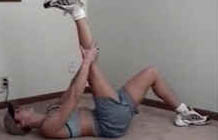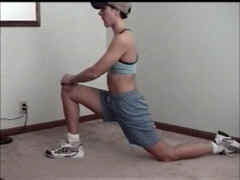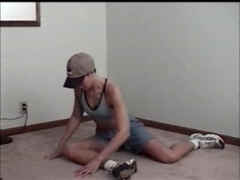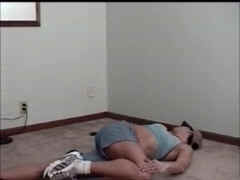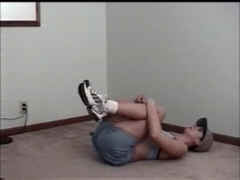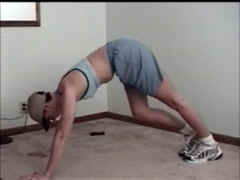The right home exercise equipment can add variety, convenience and consistency to your workouts. But too often, after you’ve purchased a piece of equipment, you realize you’ve made a mistake. Gregory Florez, president of First Fitness, Inc., a personal training company, cautions against 10 common mistakes.
Don’t Overbuy Features
Like moths to a flame, people are drawn to cardiovascular equipment that has every conceivable readout and calculation. These gadgets often go unused, thorough, so they may not be the best place to spend your money.
The right home exercise equipment can add variety, convenience and consistency to your workouts. But too often, after you’ve purchased a piece of equipment, you realize you’ve made a mistake.
Don’t Skimp on the Basic
Sturdy construction and smooth, quiet operation are what matter most. For example, with treadmills, good deck cushioning and stability are key factors to look for.
The right home exercise equipment can add variety, convenience and consistency to your workouts. But too often, afteryou’ve purchased a piece of equipment, you realize you’ve made a mistake. mistakes.
Avoid Fast or Sight-Unseen Purchasing
Almost any treadmill feel fine during the first few minutes. Only when doing a longer workout will you notice things like excessive vibration and noise. For cardio machines, spend at least 20 minutes trying different programs; for strength equipment, do a set of 10 repetitions.
The right home exercise equipment can add variety, convenience and consistency to your workouts. But too often, after you’ve purchased a piece of equipment, you realize you’ve made a mistake.
Don’t Ignore the Top of the Line.
If you don’t try the best equipment first, you won’t know what quality features to look for. Florez advises staying away from infomercial products or other low-price equipment. A store specializing in fitness equipment is probably the best place to start your search. It’s not a bad idea to stick to brands you’ve used at health clubs—a manufacturer’s quality often carries over into home models.
The right home exercise equipment can add variety, convenience and consistency to your workouts. But too often, after you’ve purchased a piece of equipment, you realize you’ve made a mistake.
Don’t Overestimate Your Abilities
An exercise or movement that looks easy on TV may not work for you. For example, ski machines with independent upper- and lower-body motion may offer an outstanding cardio workout, but they also require a high level of concentration and coordination. People are less likely to use machine that have a high learning curve. When purchasing a strength training machine, look for one with simple procedures for changing weights. If adjusting the weight isn’t mind-numbingly simple, you’re likely not to do it!
The right home exercise equipment can add variety, convenience and consistency to your workouts. But too often, after you’ve purchased a piece of equipment, you realize you’ve made a mistake.
Don’t Limit Your Options
Although treadmills are extremely popular and reliable, elliptical trainers also provide functional movement with lots of variety. Stationary bikes—both upright and recumbent—are rebounding in popularity. Stair steppers, rowing machines, home gyms and equipment for exercise based on the work of Joseph Pilates are additional options.
The right home exercise equipment can add variety, convenience and consistency to your workouts. But too often, after you’ve purchased a piece of equipment, you realize you’ve made a mistake.
Don’t Ignore Your Personal Comfort
Make sure the rowing machine you are thinking of buying doesn’t put too many demands on your back. If you are looking at treadmills and are overweight or have orthopedic concerns, check for sturdy handrails, gradual pace changes and structural integrity. Look for a home gym that will adjust to your body height and size.
The right home exercise equipment can add variety, convenience and consistency to your workouts. But too often, after you’ve purchased a piece of equipment, you realize you’ve made a mistake.
Don’t Believe Everything You Hear.
Some fitness products that sound great on infomercials have limited effectiveness. Abdominal exercise devices, for example, don’t really offer any results beyond those achieved without equipment. (However, the devices can provide some head and neck support, if they fit your body size properly.)
The right home exercise equipment can add variety, convenience and consistency to your workouts. But too often, after you’ve purchased a piece of equipment, you realize you’ve made a mistake.
Don’t Go It Alone.
Ask questions of other exercisers and fitness professionals, as well as equipment representatives. Before buying, find out about equipment delivery, setup, warranties and return policies.
The right home exercise equipment can add variety, convenience and consistency to your workouts. But too often, after you’ve purchased a piece of equipment, you realize you’ve made a mistake.
Don’t Overlook the Little Things.
Not all effective exercise equipment needs assembly and takes a lot of space. Heart rate monitors are highly recommended by many personal trainers. Fitness balls, bands, tubing and exercise videos can also add safety, creativity, comfort and variety to your activity program. The best investment of all may well be the least expensive—a water bottle!

